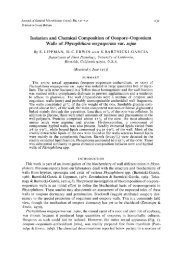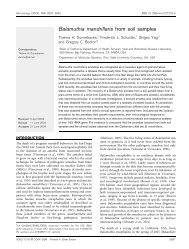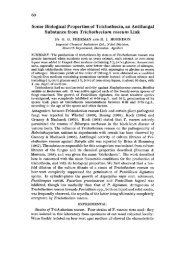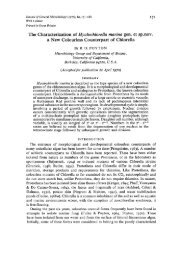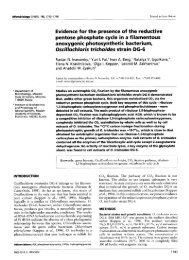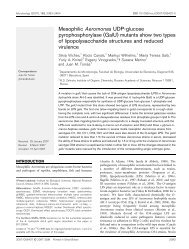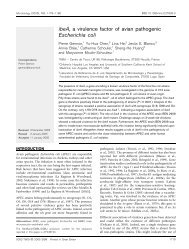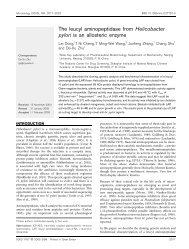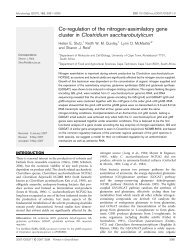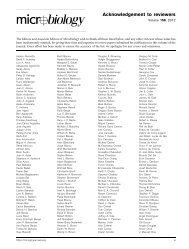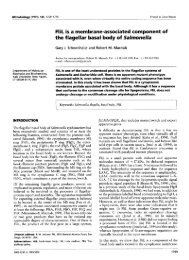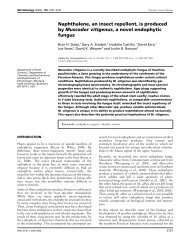Gloeocapsa (Gloeothece) sp. CCAP 143013 - Microbiology
Gloeocapsa (Gloeothece) sp. CCAP 143013 - Microbiology
Gloeocapsa (Gloeothece) sp. CCAP 143013 - Microbiology
Create successful ePaper yourself
Turn your PDF publications into a flip-book with our unique Google optimized e-Paper software.
890<br />
J. H. THOMAS AND OTHERS<br />
Table 4. Eflects of glutamine and glutamate on the inhibition of acetylene reduction by<br />
analogues of glutamine<br />
The assays were done as described for Table 2. The rates of acetylene reduction are typical; the<br />
percentages are the means of at least 12 observations. The figures in parentheses show these<br />
percentages after correction for the effect of the second addition (see Table 2).<br />
Acetylene reduction Percentage of<br />
[pmol min-I uninhibited<br />
Addition ( lo6 cells)-'] activity<br />
None 22.2 100<br />
2 mM-Azaserine 2.4 11<br />
2 mM-Azaserhe + 2 mM-glutamine 3.9 18 (29)<br />
2 mM-Azaserine + 2 mM-glutamate 3.1 14 (17)<br />
2 mM-Azaserine + 2 mM-MSX 10.9 49 (72)<br />
2 mM-Albizziine 2.0 9<br />
2 mM-Albizziine + 2 mM-glutamine 2.2 10 (16)<br />
2 mM-S-Carbamoyl cysteine<br />
2 mM-S-Carbamoyl cysteine +<br />
2 mM glutamine<br />
Table 5. Eflect of glutamic acid-y-hydrazide on acetylene reduction<br />
Where cells were used, they were collected from batch cultures of <strong>Gloeocapsa</strong> after 6 to 10 d growth.<br />
After incubation for 4 h in 150 ml Erlenmeyer flasks, the flasks were sealed, acetylene was added,<br />
where indicated, to 2% (vh) and, following a further 60 min incubation, 1 ml of the gas phase was<br />
subjected to gas chromatography. The results are the means of five separate observations.<br />
Incubation*<br />
<strong>Gloeocapsa</strong> culture + C2H2<br />
<strong>Gloeocapsa</strong> culture, no C2H2<br />
Distilled water + C2H2<br />
Distilled water, no C2H2<br />
<strong>Gloeocapsa</strong> culture + 2 mwglutamic<br />
Ethylene produced<br />
(pmol min-' ml-l)<br />
8.3<br />
0<br />
0<br />
0<br />
acid-y-hydrazide + C2H2<br />
<strong>Gloeocapsa</strong> culture + 2 mwglutamic<br />
25.0<br />
acid-y-hydrazide, no C2H2<br />
Distilled water + 2 mM-glutamic<br />
acid-y-hydrazide + C2H2<br />
Distilled water + 2 mM-glutamic<br />
3.7<br />
18.5<br />
acid-y-hydrazide, no C,H2 1.0<br />
* The volume of culture or distilled water was 50 ml in each case.<br />
azaserine, 2 mM-AOCP did not inhibit glutamine synthetase but markedly inhibited acetylene<br />
reduction by cultures of <strong>Gloeocapsa</strong> (Table 2). This suggests that carbamoyl pho<strong>sp</strong>hate is<br />
probably not the inhibitor. Furthermore, because azaserine inhibits many metabolic reactions<br />
involving glutamine (Buchanan, 1973), the inhibitor may well be glutamine itself. However,<br />
this has not been demonstrated. Unlike the other glutamine analogues, AOCP may have<br />
reversed, slightly, the effect of NHt on acetylene reduction by <strong>Gloeocapsa</strong> (Table 3).<br />
However, this effect of AOCP, though consistent, was never great and was only really<br />
apparent after correction for the inhibition caused by AOCP itself. Such correction may<br />
not be valid, so it would be unwise to attach much significance to these observations.<br />
At 2 mM, glutamic acid- y-hydrazide, another glutamine analogue, apparently markedly<br />
stimulated acetylene reduction by <strong>Gloeocapsa</strong> (Table 2). However, detailed examination of<br />
the effect of this analogue (Table 5) showed that a compound chromatographically indis-



